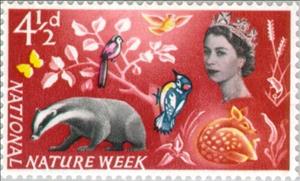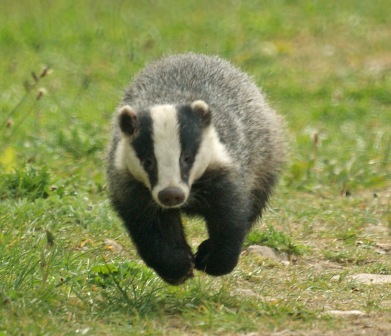Stamp: European Badger (Meles meles), Roe Deer (Capreolus capreolus (United Kingdom of Great Britain & Northern Ireland 1963)
European Badger (Meles meles), Roe Deer (Capreolus capreolus (United Kingdom of Great Britain & Northern Ireland 1963)
16 May (United Kingdom of Great Britain & Northern Ireland ) within release National Nature Week goes into circulation Stamp European Badger (Meles meles), Roe Deer (Capreolus capreolus face value 4½ British penny
| Stamp European Badger (Meles meles), Roe Deer (Capreolus capreolus in catalogues | |
|---|---|
| Michel: | Mi:GB 358 |
| Yvert et Tellier: | Yt:GB 374 |
| Stanley Gibbons: | Sg:GB 638 |
| AFA number: | AFA:GB 352 |
Stamp is horizontal format.
Also in the issue National Nature Week:
- Stamp - Buttercup, Common Daisy, Honey Bee (Apis sp.) face value 3;
- Stamp - Buttercup, Common Daisy, Honey Bee (Apis sp.) - Phosphor face value 3;
- Stamp - European Badger (Meles meles), Roe Deer (Capreolus capreolus face value 4½;
- Stamp - European Badger (Meles meles), Roe Deer (Capreolus capreolus face value 4½;
- Stamp - Buttercup, Common Daisy, Honey Bee (Apis sp.) - Phosphor face value 3;
Stamp European Badger (Meles meles), Roe Deer (Capreolus capreolus it reflects the thematic directions:
Special Occasions
Birds (Aves), a subgroup of Reptiles, are the last living examples of Dinosaurs. They are a group of endothermic vertebrates, characterised by feathers, toothless beaked jaws, the laying of hard-shelled eggs, a high metabolic rate, a four-chambered heart, and a strong yet lightweight skeleton. Birds live worldwide and range in size from the 5 cm (2 in) bee hummingbird to the 2.75 m (9 ft) ostrich. They rank as the class of tetrapods with the most living species, at approximately ten thousand, with more than half of these being passerines, sometimes known as perching birds. Birds are the closest living relatives of crocodilians.
Mammals are any vertebrates within the class Mammalia (/məˈmeɪli.ə/ from Latin mamma "breast"), a clade of endothermic amniotes distinguished from reptiles (including birds) by the possession of a neocortex (a region of the brain), hair, three middle ear bones and mammary glands. All female mammals nurse their young with milk, secreted from the mammary glands. Mammals include the largest animals on the planet, the great whales. The basic body type is a terrestrial quadruped, but some mammals are adapted for life at sea, in the air, in trees, underground or on two legs. The largest group of mammals, the placentals, have a placenta, which enables the feeding of the fetus during gestation. Mammals range in size from the 30–40 mm (1.2–1.6 in) bumblebee bat to the 30-meter (98 ft) blue whale. With the exception of the five species of monotreme (egg-laying mammals), all modern mammals give birth to live young. Most mammals, including the six most species-rich orders, belong to the placental group. The largest orders are the rodents, bats and Soricomorpha (shrews and allies). The next three biggest orders, depending on the biological classification scheme used, are the Primates (apes and monkeys), the Cetartiodactyla (whales and even-toed ungulates), and the Carnivora (cats, dogs, seals, and allies).
Environmental protection is the practice of protecting the natural environment by individuals, groups and governments.Its objectives are to conserve natural resources and the existing natural environment and, where it is possible, to repair damage and reverse trends.
Animals are multicellular, eukaryotic organisms of the kingdom Animalia (also called Metazoa). All animals are motile, meaning they can move spontaneously and independently, at some point in their lives. Their body plan eventually becomes fixed as they develop, although some undergo a process of metamorphosis later on in their lives. All animals are heterotrophs: they must ingest other organisms or their products for sustenance.
Badgers are short-legged omnivores in the family Mustelidae (which also includes the otters, wolverines, martens, minks, polecats, weasels, and ferrets). Badgers are a polyphyletic rather than a natural taxonomic grouping, being united by their squat bodies and adaptions for fossorial activity. All belong to the caniform suborder of carnivoran mammals.






